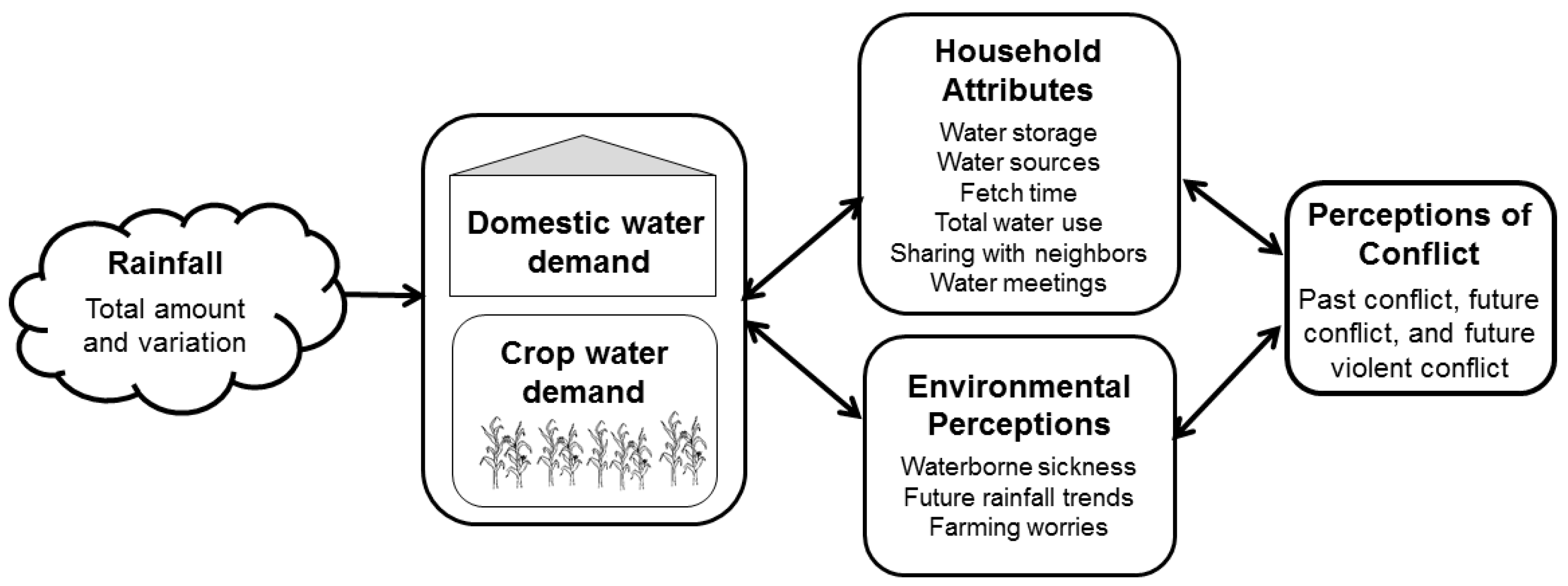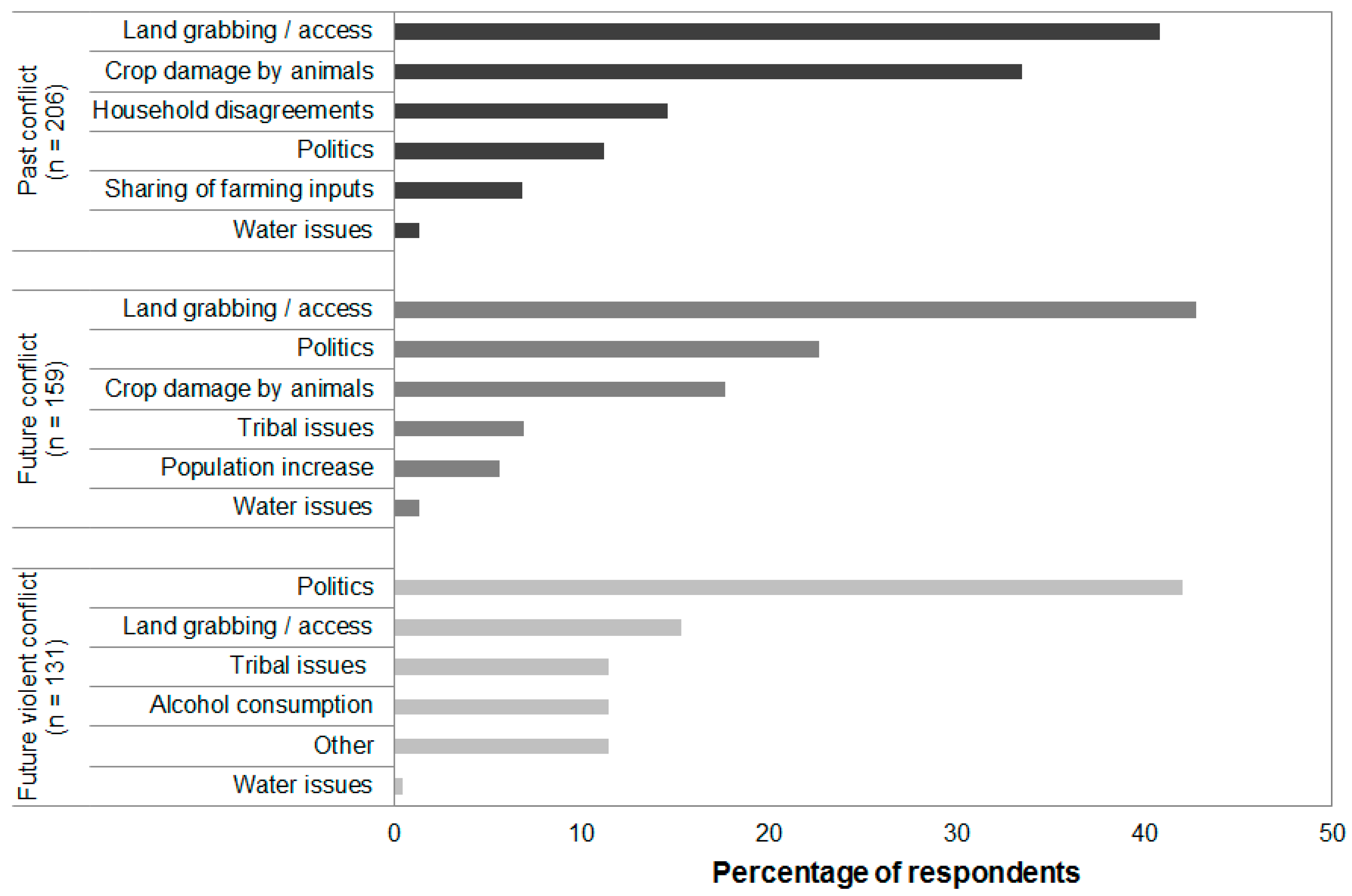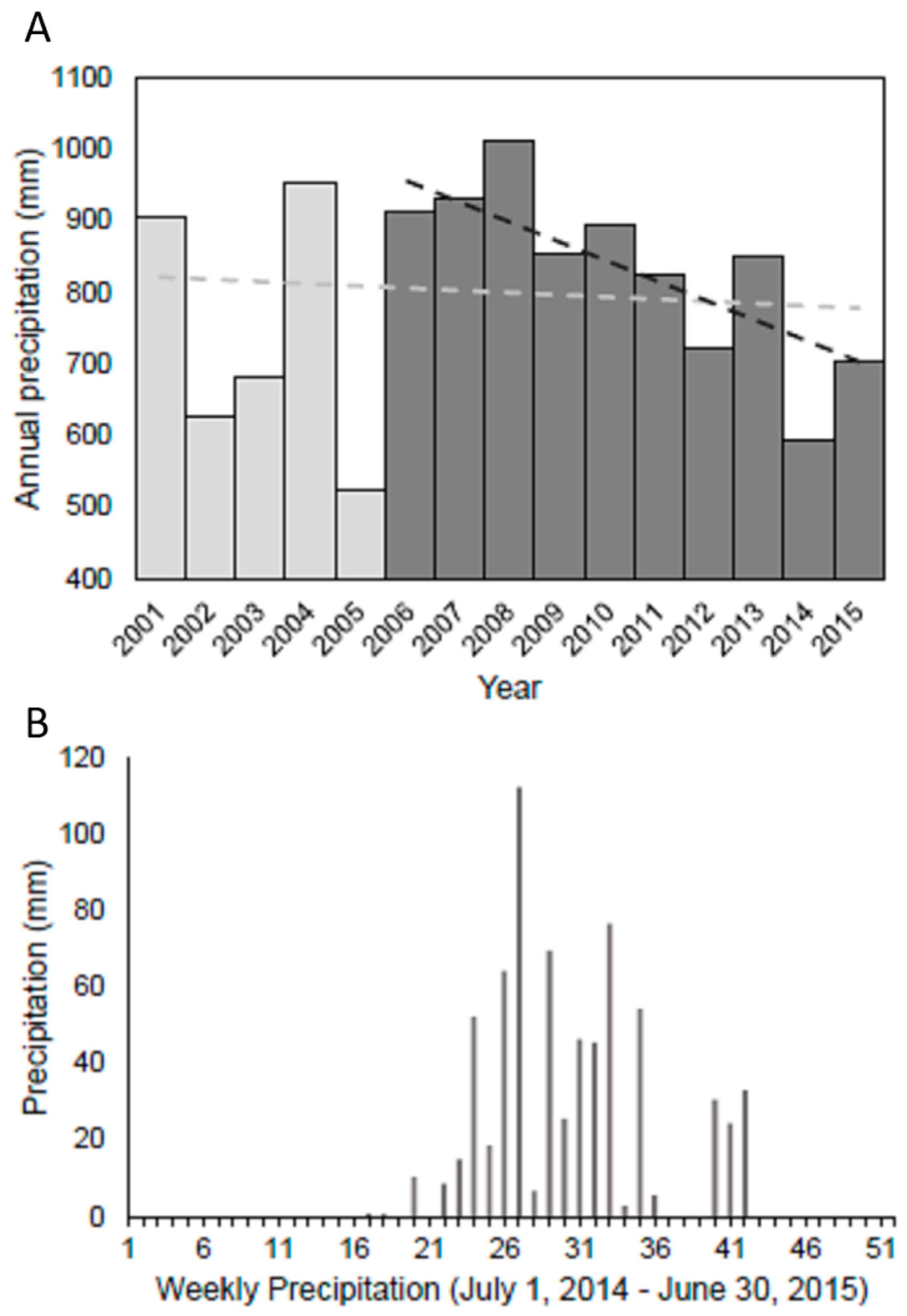Farmer Perceptions of Conflict Related to Water in Zambia
Abstract
:1. Introduction
2. Methods and Materials
2.1. Study Location
2.2. Household-Level Surveys
2.3. Survey
- Socio-demographic questions focusing on age, gender, education, household size, etc.
- Open-ended questions focusing on sources of worries, definitions of conflict, and sources of conflict. Respondents were asked to provide their perceptions of whether they had experienced conflict in the past ten years and if they perceived they would experience conflict and violent conflict in the next ten years. If respondents said yes, they were asked about the sources of conflict.
- Questions asking about water needs, specifically focusing on household, crop, and cattle water needs.
- Questions on perceptions of rainfall trends, capturing temporal variations, focusing on the past ten years, last year, and next year.
2.4. Respondent Characteristics
2.5. Ethical Approval and Informed Consent
3. Results
3.1. Overview
- (a)
- Respondent’s definition of conflict: “How would you define conflict (kuzwangana)?”
- (b)
- Past conflict: “Based on your definition, have you observed conflict around your area in the past ten years?” (Yes, No)
- (c)
- Future conflict: “Based on your definition, do you expect any forms of conflict around your area in the next ten years?” (Yes, No)
- (d)
- Future physical violent conflict: “Do you expect any physical violence in the next ten years?” (Yes, No)
3.2. Definition and Sources of Conflict
3.3. Modeling Perceptions of Water Needs, Conflict, and Violence
3.4. Independent Variables Used in the Model
3.5. Model Results
4. Discussion
5. Conclusions
Supplementary Materials
Acknowledgments
Author Contributions
Conflicts of Interest
References and Notes
- Intergovernmental Panel on Climate Change (IPCC). Summary for policymakers. In Climate Change 2014: Impacts, Adaptation, and Vulnerability. Part A: Global and Sectoral Aspects; Field, C.B., Barros, V.R., Dokken, D.J., Mach, K.J., Mastrandrea, M.D., Bilir, T.E., Chatterjee, M., Ebi, K.L., Estrada, Y.O., Genova, R.C., et al., Eds.; Cambridge University Press: New York, NY, USA, 2014. [Google Scholar]
- UN-Water. Climate Change Adaptation: The Pivotal Role of Water; UN Water Program; United Nations: New York, NY, USA, 2010. [Google Scholar]
- Gemenne, F.; Barnett, J.; Adger, W.N.; Dabelko, G.D. Climate and security: Evidence, emerging risks, and a new agenda. Clim. Chang. 2014, 123, 1–9. [Google Scholar] [CrossRef]
- Gleditsch, N.P.; Wallensteen, P.; Eriksson, M.; Sollenberg, M.; Strand, H. Armed Conflict 1946–2001: A New Dataset. J. Peace Res. 2002, 39, 615–637. [Google Scholar] [CrossRef]
- Hsiang, S.M.; Meng, K.C. Reconciling Disagreement Over Climate-Conflict Results in Africa. Proc. Natl. Acad. Sci. USA 2014, 111, 2100–2103. [Google Scholar] [CrossRef] [PubMed]
- O’Loughlin, J.; Linke, A.M.; Witmer, F.D. Modeling and data choices sway conclusions about climate-conflict links. Proc. Natl. Acad. Sci. USA 2014, 111, 2054–2055. [Google Scholar] [CrossRef] [PubMed]
- Salehyan, I.; Hendrix, C.S. Climate shocks and political violence. Glob. Environ. Chang. 2014, 28, 239–250. [Google Scholar] [CrossRef]
- Carius, A.; Dabelko, G.D.; Wolf, A.T. The United Nations and Environmental Security: Water, Conlict, and Cooperation; Environmental Change and Security Program Report; United Nations: New York, NY, USA, 2004; Volume 10, pp. 60–66. [Google Scholar]
- Adger, W.N. Vulnerability. Glob. Environ. Chang. 2006, 16, 268–281. [Google Scholar] [CrossRef]
- Tschakert, P. Environmental services and poverty reduction: Options for smallholders in the Sahel. Agric. Syst. 2007, 94, 75–86. [Google Scholar] [CrossRef]
- Adger, W.N. Climate Change, Human Well-Being and Insecurity. New Political Econ. 2010, 15, 275–292. [Google Scholar] [CrossRef]
- Tirado, M.C.; Cohen, M.J.; Aberman, N.; Meerman, J.; Thompson, B. Addressing the challenges of climate change and biofuel production for food and nutrition security. Food Res. Int. 2010, 43, 1729–1744. [Google Scholar] [CrossRef]
- Intelligence Community Assessment (ICA). Intelligence Community Assessment: Global Food Security; Office of the Director of National Intelligence NIC, Ed.; Office of the Director of National Intelligence NIC: Washington, DC, USA, 2015; pp. 1–58.
- Hsiang, S.M.; Burke, M. Climate, conflict, and social stability: What does the evidence say? Clim. Chang. 2013, 123, 39–55. [Google Scholar] [CrossRef]
- Hsiang, S.M.; Burke, M.; Miguel, E. Quantifying the influence of climate on human conflict. Science 2013, 341, 1235367. [Google Scholar] [CrossRef] [PubMed]
- Hsiang, S.M.; Burke, M.; Miguel, E. Climate and conflict. Natl. Bur. Econ. Res. 2014, 7, 577–617. [Google Scholar]
- Hsiang, S.M.; Meng, K.C.; Cane, M.A. Civil conflicts are associated with the global climate. Nature 2011, 476, 438–441. [Google Scholar] [CrossRef] [PubMed]
- Homer-Dixon, T.F. On the Threshold: Environmental changes as causes of acute conflict. Int. Secur. 1991, 16, 76–116. [Google Scholar] [CrossRef]
- Ohlsson, L. Water Scarcity and Conflict. Int. Secur. Chall. Chang. World 1992, 3, 211–234. [Google Scholar]
- Ohlsson, L. Environmental Scarcity and Violent Conflict: The case of Rwanda. J. Environ. Dev. 1996, 5, 270–291. [Google Scholar]
- Percival, V.; Homer-Dixon, T.F. Environmental Scarcity and Violent Conflict: The Case of South Africa. J. Peace Res. 1998, 35, 279–298. [Google Scholar] [CrossRef]
- Krug, E.G.; Dahlberg, L.L.; Mercy, J.A.; Zwi, A.B.; Lozano, R. World Report on Violence and Health; World Health Organization: Geneva, Switzerland, 2002. [Google Scholar]
- Barnett, J.; Adger, W.N. Climate change, human security and violent conflict. Political Geogr. 2007, 26, 639–655. [Google Scholar] [CrossRef]
- Nordås, R.; Gleditsch, N.P. Climate change and conflict. Political Geogr. 2007, 26, 627–638. [Google Scholar] [CrossRef]
- Raleigh, C.; Urdal, H. Climate change, environmental degradation and armed conflict. Political Geogr. 2007, 26, 674–694. [Google Scholar] [CrossRef]
- Gizelis, T.-I.; Wooden, A.E. Water resources, institutions, & intrastate conflict. Political Geogr. 2010, 29, 444–453. [Google Scholar] [CrossRef]
- Devlin, C.; Hendrix, C.S. Trends and triggers redux: Climate change, rainfall, and interstate conflict. Political Geogr. 2014, 43, 27–39. [Google Scholar] [CrossRef]
- Von Uexkull, N. Sustained drought, vulnerability and civil conflict in Sub-Saharan Africa. Political Geogr. 2014, 43, 16–26. [Google Scholar] [CrossRef]
- Böhmelt, T.; Bernauer, T.; Buhaug, H.; Gleditsch, N.P.; Tribaldos, T.; Wischnath, G. Demand, supply, and restraint: Determinants of domestic water conflict and cooperation. Glob. Environ. Chang. 2014, 29, 337–348. [Google Scholar] [CrossRef]
- Kelley, C.P.; Mohtadi, S.; Cane, M.A.; Seager, R.; Kushnir, Y. Climate change in the Fertile Crescent and implications of the recent Syrian drought. Proc. Natl. Acad. Sci. USA 2015, 112, 3241–3246. [Google Scholar] [CrossRef] [PubMed]
- Buhaug, H.; Benaminsen, T.A.; Sjaastad, E.; Theisen, O.M. Climate variability, food production shocks, and violent conflict in Sub-Saharan Africa. Environ. Res. Lett. 2015, 10, 125015. [Google Scholar] [CrossRef]
- Salehyan, I. From Climate Change to Conflict? No Consensus Yet. J. Peace Res. 2008, 45, 315–326. [Google Scholar] [CrossRef]
- Salehyan, I.; Hendrix, C.S.; Hamner, J.; Case, C.; Linebarger, C.; Stull, E.; Williams, J. Social Conflict in Africa: A new database. Int. Interact. 2012, 38, 503–511. [Google Scholar] [CrossRef]
- Raleigh, C.; Linke, A.; Hegre, H.; Karlsen, J. Introducing ACLED-Armed Conflict Location and Event Data. J. Peace Res. 2010, 47, 651–660. [Google Scholar] [CrossRef]
- Linke, A.M.; O’Loughlin, J.; McCabe, J.T.; Tir, J.; Witmer, F.D.W. Rainfall variability and violence in rural Kenya: Investigating the effects of drought and the role of local institutions with survey data. Glob. Environ. Chang. Hum. Policy Dimens. 2015, 34, 35–47. [Google Scholar] [CrossRef]
- Tschakert, P. The costs of soil carbon sequestration: An economic analysis for small-scale farming systems in Senegal. Agric. Syst. 2004, 81, 227–253. [Google Scholar] [CrossRef]
- Tschakert, P. Views from the vulnerable: Understanding climatic and other stressors in the Sahel. Glob. Environ. Chang. 2007, 17, 381–396. [Google Scholar] [CrossRef]
- Adams, W.M.; Brockington, D.; Dyson, J.; Vira, B. Managing tragedies: Understanding conflict over common pool resources. Science 2003, 302, 1915–1916. [Google Scholar] [CrossRef] [PubMed]
- Chisanga, K. Lack of Resilience in African Smallholder Farming: Exploring Measures to Enhance the Adaptive Capacity of Local Communities to Pressures of Climate Change; Zambian Agricultural Research Institute: Choma, Zambia, 2008. [Google Scholar]
- Stern, R.D.; Cooper, P.J.M. Assessing Climate Risk and Climate Change Using Rainfall Data—A Case Study from Zambia. Exp. Agric. 2011, 47, 241–266. [Google Scholar] [CrossRef]
- Milgroom, J.; Giller, K.E. Courting the rain: Rethinking seasonality and adaptation to recurrent drought in semi-arid southern Africa. Agric. Syst. 2013, 118, 91–104. [Google Scholar] [CrossRef]
- Mekonnen, M.M.; Hoekstra, A.Y. Four billion people facing severe water scarcity. Sci. Adv. 2016, 2, 1–6. [Google Scholar]
- Galtung, J. Violence, Peace, and Peace Research. J. Peace Res. 1969, 6, 167–191. [Google Scholar] [CrossRef]
- Galtung, J. Structural and Direct Violence: A note on operationalization. J. Peace Res. 1971, 8, 73–76. [Google Scholar] [CrossRef]
- Galtung, J. Cultural Violence. J. Peace Res. 1990, 27, 291–305. [Google Scholar] [CrossRef]
- District Agricultural Coordination Office (DACO). Choma District Farmer Register; District Agricultural Coordination Office: Choma, Zambia, 2015.
- Central Statistical Office (CSO). 2010 Republic of Zambia Census of Population and Housing; Zambia Central Statistical Office, Ed.; Zambia Central Statistical Office: Lusaka, Zambia, 2010.
- MoA, Zambian Ministry of Agriculture and Livestock: Structure and Organizaiton of the Department.
- Food and Agricultural Organization (FAO). Farmer Input Support Response Initiative (FISRI) to Rising Prices of Commodities in Zambia; Food and Agricultural Organization: Rome, Italy, 2009. [Google Scholar]
- Funder, M.; Bustamante, R.; Cossio, V.; Huong, P.T.M.; van Koppen, B.; Mweemba, C.; Nyambe, I.; Phuong, L.T.T.; Skielboe, T. Strategies of the Poorest in Local Water Conflict and Cooperation: Evidence from Vietnam, Bolivia, and Zambia. Water Altern. 2012, 5, 20–36. [Google Scholar]
- Hendrix, C.S.; Glaser, S.M. Trends and triggers: Climate, climate change and civil conflict in Sub-Saharan Africa. Political Geogr. 2007, 26, 695–715. [Google Scholar] [CrossRef]
- ZARI. Daily Precipitation Data for 2001–2015: Mochipapa Research Station; Zambian Agricultural Research Institute: Choma, Zambia, 2015.
- World Health Organization (WHO). Water-Related Diseases. Available online: http://www.who.int/water_sanitation_health/diseases-risk/diseases/diarrhoea/en/ (accessed on 14 December 2016).
- Falkenmark, M.; Berntell, A.; Jagerskog, A.; Lundqvist, J.; Matz, M.; Tropp, H. On the Verge of a New Water Scarcity: A Call for Good Governance and Human Ingenuity; Stockholm International Water Institute: Stockholm, Sweden, 2007. [Google Scholar]
- Provincial Agricultural Coordination Office (PACO). Southern Province Roads; Provincial Agricultural Coordination Office: Southern Province, Zambia, 2015.
- Gardner, R.; Ostrom, E.; Walker, J.M. The Nature of Common-Pool Resource Problems. Ration. Soc. 1990, 2, 335–358. [Google Scholar] [CrossRef]
- Cardenas, J.C. Social Norms and Behavior in the Local Commons as Seen Through the Lens of Field Experiments. Environ. Resour. Econ. 2011, 48, 451–485. [Google Scholar] [CrossRef]





| Definition of Conflict | Percentage of Respondents |
|---|---|
| Misunderstanding, miscommunicating, or not getting along | 74.6 |
| Verbal fighting or arguing between individuals | 13.4 |
| Absence of peace | 8.5 |
| Other | 3.5 |
| Time Period | Crop Water Needs | Household Water Needs |
|---|---|---|
| Past ten years | 63.8% | 50.5% |
| Last year | 3.6% | 57.6% |
| Next year | 47.8% | 58.0% |
| Parameters | Past Conflict | Future Conflict | Future Physical Violence | |||
|---|---|---|---|---|---|---|
| Estimate | SE | Estimate | SE | Estimate | SE | |
| Intercept | 0.212 | 1.466 | −1.128 | 0.986 | −4.540 **** | 1.110 |
| Past crop water needs met | −0.341 | 0.703 | −0.319 | 0.387 | 0.811 ** | 0.377 |
| Future crop water needs met | 0.328 | 0.658 | 0.314 | 0.411 | 1.151 ** | 0.466 |
| Past household water needs met | −0.075 | 0.665 | −0.412 | 0.389 | 0.059 | 0.371 |
| Future household water needs met | −0.447 | 0.754 | 0.036 | 0.411 | 0.131 | 0.394 |
| Water as a general worry | 1.657 | 1.142 | 0.824 * | 0.476 | −0.572 | 0.414 |
| Water as a farming worry | 1.043 | 0.730 | −0.263 | 0.394 | 0.950 ** | 0.404 |
| Rains decrease in future | 0.931 | 0.647 | 0.839 ** | 0.426 | 1.884 **** | 0.477 |
| Sickness | 1.193 | 1.132 | 0.570 | 0.434 | 1.148 *** | 0.417 |
| Attends water meetings | 1.312 ** | 0.577 | 1.248 **** | 0.369 | 0.794 ** | 0.376 |
| Past water disputes | 0.521 | 0.624 | −0.236 | 0.378 | 0.780 ** | 0.370 |
| Future water disputes increase | 0.302 | 0.710 | 0.527 | 0.386 | 0.656 * | 0.386 |
| Water use per person per day | −0.003 | 0.026 | 0.052 *** | 0.019 | 0.024 | 0.016 |
| Water fetch time per person per day | 0.066 | 0.043 | −0.002 | 0.010 | 0.006 | 0.009 |
| Distance to Choma (km) | −0.021 | 0.036 | −0.007 | 0.022 | −0.006 | 0.021 |
| Distance to Improved Surface Road (km) | 0.120 | 0.111 | −0.012 | 0.057 | −0.038 | 0.060 |
| Male | 1.064 * | 0.588 | 0.106 | 0.361 | 0.173 | 0.350 |
| Education | −0.073 | 0.080 | −0.011 | 0.054 | 0.060 | 0.053 |
© 2018 by the authors. Licensee MDPI, Basel, Switzerland. This article is an open access article distributed under the terms and conditions of the Creative Commons Attribution (CC BY) license (http://creativecommons.org/licenses/by/4.0/).
Share and Cite
Marcantonio, R.A.; Attari, S.Z.; Evans, T.P. Farmer Perceptions of Conflict Related to Water in Zambia. Sustainability 2018, 10, 313. https://doi.org/10.3390/su10020313
Marcantonio RA, Attari SZ, Evans TP. Farmer Perceptions of Conflict Related to Water in Zambia. Sustainability. 2018; 10(2):313. https://doi.org/10.3390/su10020313
Chicago/Turabian StyleMarcantonio, Richard A., Shahzeen Z. Attari, and Tom P. Evans. 2018. "Farmer Perceptions of Conflict Related to Water in Zambia" Sustainability 10, no. 2: 313. https://doi.org/10.3390/su10020313





